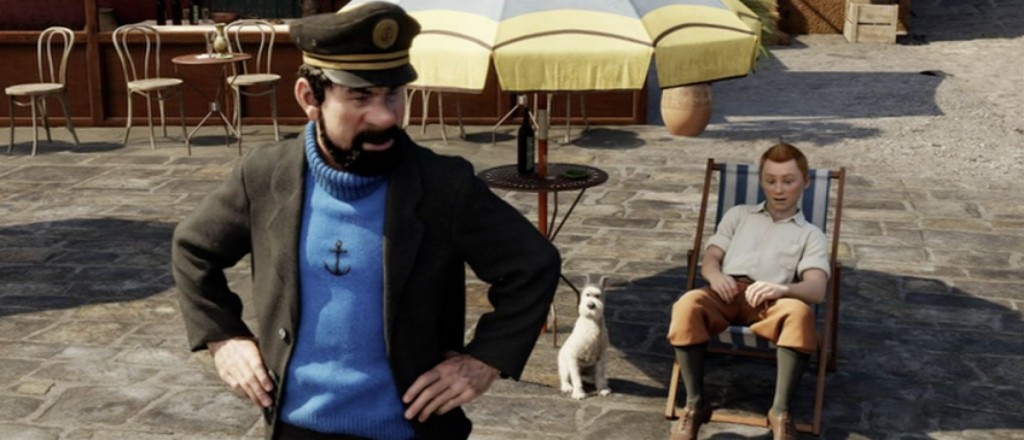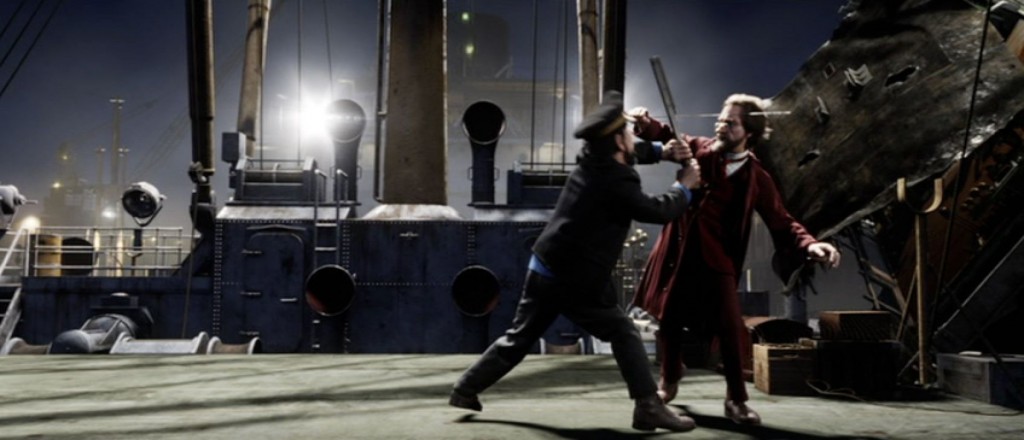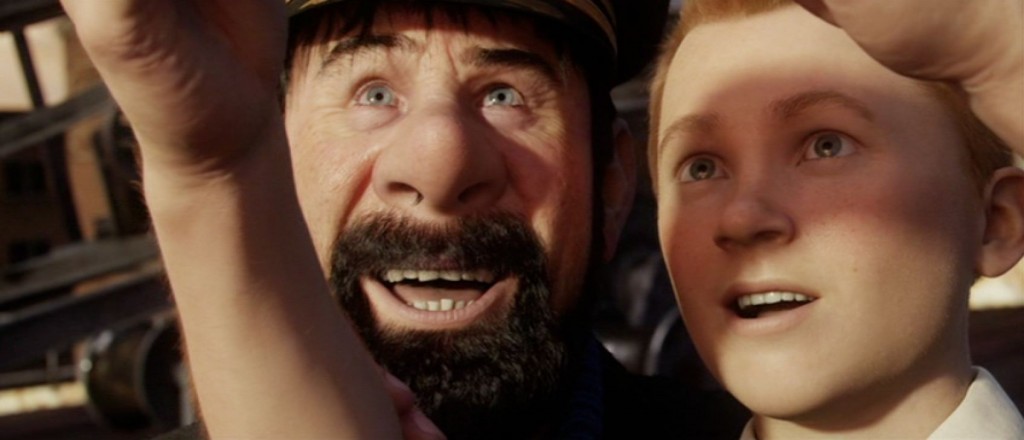Spielberg: The Adventures of Tintin part 8
Tintin and Haddock are at an impasse. Tintin has lost the scrolls and his story, which means, to him, his identity — he is his story. Haddock has lost his ship — again — and thus his connection to his family. Tintin, despondent, is ready to give up, but Haddock bucks him up with what he intends to be a big inspirational speech on the nature of failure. Haddock succeeds, but not in the way he intended — instead, his truncated inspirational speech gives Tintin a practical idea, to track Sakharine by radio. Spielberg builds up a sentimental moment, then sweeps away the sentiment with a nuts-and-bolts answer — Tintin is not about introspection but action.
And so we plunge into the breathless Act III as the Karaboudjan comes to dock, right back where it set out, the city where Tintin lives. Sakharine, it seems, has pulled a Dorothy, gone searching the world over for his heart’s content only to learn it was in his own backyard. He gets into his car, to be taken back to Marlinspike Hall, only to find that his butler has betrayed him, a reversal of Haddock’s first mate’s betrayal aboard the Karaboudjian. That reversal leads to Tintin‘s final set-piece, a swordfight between Haddock and Sakharine, each fighting for the honor of his family, a reprise of the swordfight between Sir Francis and Red Rackham, this time with loading cranes. Why Sakharine would need to fight Haddock with something as absurdly complicated as a loading crane I have no idea, but the spectacle speaks for itself — it’s high comedy, it’s nothing we’ve ever seen before, and it’s thrillingly realized. (Sakharine being the descendant of Rackham is, incidentally, an invention of the screenplay: in the original comic he was an innocent model-boat enthusiast. Spielberg made him the kin of Rackham to bring him equal to Haddock, to make the struggle not just man-against-man but family-against-family.)
It may seem odd that The Adventures of Tintin devotes its entire third act to Haddock while Tintin frets on the sidelines, but the narrative has been headed this way from the beginning. The maguffin — the secret of the Unicorn — may have been Tintin’s story to find, but it was always Haddock’s cross to bear, and, as I’ve noted earlier, Tintin’s arc, whether he knows it or not, is to bring Haddock his heritage. Tintin, as a character, doesn’t bear the weight of family, he must remain above the fray of common human interest, but Haddock, even in his loopy, hapless state, does. A boy adventurer knows nothing of loss, but Haddock — the older Tintin, lost in his alcoholic cloud — does. In the end, Haddock beats Sakharine, not with the sword or the crane, but with alcohol — throwing bottles of it at him on the deck of the Karaboudjan until Sakharine falls overboard and is hauled out by Thomson and Thompson, who, for once, perform actual police work.
As the sun comes up on the docks, Spielberg cannot resist a “Spielberg shot” — characters gazing in wonder at something just off-camera. There is even a subtle joke involved: usually, the Spielberg Shot is a dolly in, but here Spielberg, always following the dictum to invert the cliche, here starts in close and dollies out. “Do you see?” asks Tintin as the sun shines through the scrolls. Another self-quote, this time from Minority Report, a movie obsessed with vision, sight, and the accuracy of what one sees, applied here to pull together all the lenses and framing devices employed to make Tintin a meta-text.
The scrolls’ coordinates lead Haddock — where else — home. Specifically, his boyhood home. Spielberg has often spoken of the power of one’s boyhood home — it’s where dreams are built, after all — and by making Marlinspike Hall Haddock’s home, Spielberg takes ownership of the character. Tintin may be Spielberg’s retreat into his childhood, but Haddock is who he is now, a man looking back. At the end of Indiana Jones and the Kingdom of the Crystal Skull, Indian Jones says “Knowledge was their treasure,” but in Tintin the treasure is, literally, in the boyhood home, waiting in the secret room, the place where a boy plays his games, makes his plans, dreams his dreams, writes his adventures into his life and turns his life into his adventures, all in innocence, long before responsibilities arrive to carry him away.



It amuses me that Tintin can never enter Marlinspike Hall’s grounds through the gate, but always through some alternative method–crawling through a hole in the wall or driving a car through a hedge. (And that both methods get repeated in the cellar scene: hole in the wall, busting through the wall. A perfect combination since Tintin/Snowy is the clue-finder who goes through tiny holes/clues and Haddock is the one who advocates pushing through walls/brute force.)
I know the whole “Eagle’s cross” thing is taken from Red Rackham’s Treasure, though I want it to mean more here–is it here so that Tintin can contribute some book-learning? (Although, Biblical quibble (from a Jew): I don’t think St. John of Patmos is “John the Evangelist” as Tintin says–that’s the other John.)
Lastly, if the dead Haddock wanted a true Haddock to find the treasure that means he wanted someone who (a) could look at a globe and know an island didn’t belong; (b) would collect all three of the Unicorn models that went to three different families; and (c) somehow break those models to discover the hidden message. I like (b) because it emphasizes the importance of family–all three brothers would have to work together with their models or someone else would have to collect all the family heirlooms. But (c) is odd, as if he were planning for a clumsy drunk of an heir.